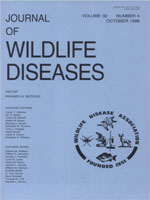A free-living adult male gopher tortoise (Gopherus polyphemus) was found on Sanibel Island, Florida (USA), on 18 February 1992 with signs of upper respiratory disease. On necropsy after euthanasia on 27 February 1992, severe, extensive necrotizing ulcerative tracheitis, multifocal necrotizing pneumonia, and multifocal necrotizing ulcerative pharyngitis and esophagitis were observed. Large ovoid to round intracytoplasmic basophilic inclusions, which appeared to displace the nucleus to the cell periphery, occurred within degenerate and necrotic epithelial cells of the above tissues. On transmission electron microscopy of formalin-fixed trachea and lung, intracytoplasmic viral particles were observed within necrotic cells in the tracheal lumen and epithelial cells of the lung. Most infected cells also had a roughly spherical granular cytoplasmic inclusion that contained clusters of viral particles. Viral particles had an electron dense spherical to icosahedral core surrounded by a less electron dense icosahedral capsid. Mature extracellular virions were surrounded by an envelope and were 150 to 220 nm in diameter. Virions and cytoplasmic inclusions were morphologically similar to those of the Family Iridoviridae.
How to translate text using browser tools
1 October 1996
Respiratory and Pharyngo-Esophageal Iridovirus Infection in a Gopher Tortoise (Gopherus polyphemus)
R. A. Westhouse,
E. R. Jacobson,
R. K. Harris,
K. R. Winter,
B. L. Homer

Journal of Wildlife Diseases
Vol. 32 • No. 4
October 1996
Vol. 32 • No. 4
October 1996
esophagitis
gopher tortoise
Gopherus polyphemus
iridovirus
pharyngitis
pneumonia
tracheitis




